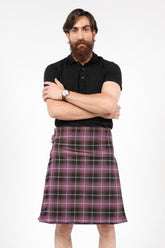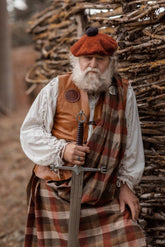Traditions of Christmas In Scotland - Vast Celebration!
History of Christmas:
Christmas is a Christian festival that celebrates the birth of Jesus Christ, who Christians believe was the son of God. The origins of Christmas stretch back thousands of years to prehistoric celebrations around the midwinter solstice. In the 1600's, during Oliver Cromwell’s rule and the Reformation in the UK, Parliament prohibited Christmas observance. Scotland, influenced by John Knox, founder of the Presbyterian Church, also banned Christmas during that period. Instead, Scotland celebrated the winter solstice known as Yule before the Reformation. The ban on Christmas in Scotland persisted even after it was lifted in other parts of the UK in 1712. In 1958, Scotland officially embraced Christmas Day as a joyous public holiday, marking a significant shift in celebration. Before 1958, Christmas was treated as a regular working day for many Scots.
Christmas Kilt - Pinnacle of Traditional Attire:
During Christmas time, many Scots proudly wear their traditional tartan kilts, which reflect their heritage and bring an authentic feel to holiday gatherings. The kilt, with its unique tartan patterns, is like a symbol of Scottish pride and tradition. It's a must-have outfit for various celebrations, such as Christmas and Hogmanay, adding a special touch to the festivities.
The kilt is a traditional attire that has been worn in Scotland for centuries. It is a symbol of Scottish heritage and culture, and is often worn during the festive season. The kilt is made from high-quality cotton and acrylic wool and is available in a variety of tartans. It is typically worn with a jacket, sporran, kilt belt, and ghillie brogues.
Scottish Christmas Traditions:
Egg Divination:
The tradition of using eggs to predict the future spouse has its roots in ancient times and is known as oomancy. Oomancy is derived from two Greek words, oon (an egg) and Manteia (divination), which translates into egg divination. Oomancy was a common form of divination in ancient Greece and was also observed among German pagans and ancient Druids. In the 17th century, the tradition was popular in New England, with young girls like Elizabeth Parris and Abigail Williams using eggs in a glass to learn about their future husbands.
In this tradition, unmarried individuals break eggs and interpret the egg whites' shapes to predict their future spouse's occupation. If the baked cake broke, it signaled bad luck. This tradition is often associated with various superstitions and beliefs about eggs, and it is sometimes part of cultural or folkloric practices.

Yule log:
The Yule log tradition is believed to have originated from Germanic or Scandinavian paganism as an early winter solstice ritual. The term "Yule Log" was first documented in 1686 and appears to have been a Nordic tradition associated with the old Winter Solstice festivals in Scandinavia and other parts of northern Europe. The Yule log was a specially selected log burned on a hearth as a winter tradition, and it was linked to the ancient Norse celebration of Yule, which commemorated the winter solstice and the return of longer days. Today, the tradition is still celebrated in some cultures as a Christmas tradition, with a large log traditionally burned in the fireplace.
The Yule log is a traditional Scandinavian and Germanic custom of burning a log on Christmas Eve, believed to ward off death in the coming year. The log is typically carved into the shape of an old woman, representing the Cailleach figure, and is placed in a fireplace or chimney. As the log burns, the flames and ashes are thought to protect the home and its inhabitants from harm and death. The Yule log tradition has been incorporated into various forms of media, such as the 1993 song "The Yule Log" by Ivor Novello and the 2013 video game "The Yule Log". While the original purpose of the Yule log was to ward off evil spirits, it has evolved to become a symbol of hearth and home, often used in Christmas decorations and celebrations.

Rowan Burning Symbolism:
The tradition of "Rowan Burning" originates in the rich mythology and folklore surrounding the rowan tree. The rowan tree has been traditionally associated with protection against witchcraft and enchantment. It was believed to possess mystical properties and was used to ward off malevolent forces and evil spirits. The tree's wood was used for various purposes, such as inscribing runes for divination and in rites of purification. In Celtic mythology, the rowan tree was considered a protective tree and was associated with the Celtic goddess Brigid, who embodied healing, poetry, and craftsmanship.
This tradition is often observed during Christmas, alongside other Scottish customs such as the "first-footer" tradition. The tradition of burning a rowan twig in Scotland is believed to have originated from the ancient practice of using rowan twigs to clear away bad feelings of jealousy or mistrust between family members, friends, or neighbors. The Rowan tree holds a special place in Scottish folklore, being associated with protection against evil spirits and witches. The rowan tree was once worshipped by Druids and was considered to offer protection from fairies and witches. It was also one of the nine sacred woods burnt in the Druids' Beltane fire. The tradition of burning a rowan twig is a way to clear away any bad feelings between loved ones, reflecting the tree's historical significance in Scottish culture.

Yule Bread:
The tradition of Yule bread in Scottish culture has its origins in the islands of Shetland and Orkney, where it was a part of the Yule festivities, a pagan tradition that coincided with the winter solstice. The baking of Yule bread was a long-standing tradition across the British Isles, but it was banned in Scotland for nearly four centuries. The Scottish Parliament passed a law in 1640 that made celebrating 'Yule vacations' illegal, and the baking of Yule bread was considered a criminal act. Despite this, the tradition survived, and Yule bread is still celebrated in Scotland today, often shared with friends and family during the holiday season.
The Yule Bread tradition is celebrated in Scotland as part of the Christmas festivities. Yule Bread is an unleavened bread baked with caraway seeds and plaited into a three-thread loaf, which is then turned into a circle to represent the "Sacred Three" and the Sun respectively. The tradition involves hiding trinkets within the bread for good luck, and whoever finds the trinket is believed to be blessed with good luck for a year. Yule Ale, specially brewed with hops, root ginger, and molasses, is also part of the celebration.

Mince Pies:
The cultural significance of mince pies is rooted in the historical and religious symbolism. Originating in England, mince pies date back to the 13th century, with their ingredients traceable to returning European crusaders who brought Middle Eastern recipes containing meats, fruits, and spices. Over time, the pies transitioned from meat to a sweet mixture of dried fruits and spices, becoming a traditional Christmas treat. The ingredients and shape of the pies were laden with Christian symbolism, representing the gifts delivered to Jesus by the Biblical Magi and elements of the Christmas story.
The pies were initially filled with minced meat, suet, and a range of fruits, but the meat was later replaced with a mixture of dried fruits and spices. The name "mince" comes from the Latin word "minutus," which means small, and has no connotation with minced meat. The pies were traditionally shaped in an oblong shape to resemble a manger and were often topped with a depiction of the Christ Child. The filling of mince pies consists of a blend of dried fruits and spices, contributing to their scrumptious taste. Despite the historical restrictions on who could bake these pies, the tradition of creating these small and delightful pies emerged as a result of these historical circumstances.

Giving Unique Christmas Gift:
Kilts make a unique and meaningful Christmas gifts in Scotland. Embodying tradition and elegance, a kilt is a thoughtful present that reflects Scottish heritage and cultural pride. Whether the recipient has Scottish roots or simply appreciates the beauty of tradition, a kilt is a timeless and cherished gift that goes beyond the ordinary. Wearing it during Christmas adds a touch of cultural significance to the festive season, making it a perfect choice for those seeking a distinctive and memorable present. Step away from conventional gifts and embrace the rich tradition of gifting a kilt, and let the spirit of togetherness shine bright during the holidays.
Reindeer:
In Scotland, the culture and symbolism of reindeer on Christmas are deeply rooted in folklore and tradition. Reindeer, particularly the white reindeer, hold a special place in Scottish and Sami folklore, where they are believed to possess magical qualities, bringing luck, riches, and eternal happiness to those who encounter them. The association of reindeer with magic and the natural world is a significant part of the culture and symbolism surrounding Christmas in Scotland.
In Scottish and Celtic mythology, the deer, including the reindeer, is associated with woodland deities and is a symbol of the regenerative power of nature. The stag, a male deer, is particularly revered and is linked to the god Cernunnos, "The Horned One," in Celtic religion. The Scottish stag, a close relative of the reindeer, is a symbol of the country's natural beauty and wilderness, making sightings of these majestic creatures rare and special. The reindeer's presence in Christmas celebrations in Scotland is a testament to the rich history, folklore, and cultural symbolism associated with this iconic animal.

Christmas Trees:
The tradition of Christmas trees on Christmas originated in Germany in the 16th century, with the first recorded instance of a Christmas tree in the Cathedral of Strasbourg in 1539. The modern Christmas tree, a symbol of the Christian faith, was introduced to North America by German settlers in the 17th century and gained popularity in the United States in the 1820s. The tradition of Christmas trees in private homes or establishments dates back to the late 18th century and early 19th century. The first Christmas tree farm was established in 1901 in New Jersey.
In Scotland, Christmas trees are decorated with a variety of ornaments that reflect Scottish culture and traditions. These ornaments include tartan decorations, Scottish thistle ornaments, and Highland cow ornaments. Some ornaments feature bagpipers, while others depict Scottish historical figures such as Robert the Bruce. Many of these ornaments are handmade using traditional techniques. In addition to traditional Scottish ornaments, Christmas trees in Scotland may also be decorated with more general Christmas decorations such as snowflakes and angels. Overall, Scottish Christmas tree decorations are a unique and festive way to celebrate the holiday season while showcasing Scottish heritage and culture.

Christmas Eve Bible Reading:
The Christmas Eve Bible reading tradition is celebrated in many Christian households as a time to reflect on the birth of Jesus Christ. Families gather to read the Christmas story from the Bible, such as the second chapter of the book of Luke, emphasizing the true meaning of Christmas. This tradition symbolizes the humble beginnings of Jesus and serves as a reminder of the real reason for the season.
Bible reading tradition is celebrated in various ways, with rich symbolism. In some cultures, such as Scotland, farmers read a Bible chapter behind their animals in the byre or stable on Christmas Eve to seek protection for the coming year. This tradition reflects a deep sense of care and responsibility for the well-being of the animals. Additionally, in Iceland, the Jólabókaflóð, or "Christmas Book Flood," is a beloved tradition where books are exchanged as gifts on Christmas Eve, and the evening is spent reading and sharing stories with loved ones. This tradition symbolizes the joy of literature and the importance of spending quality time with family and friends during the festive season.

First Footing Tradition:
The tradition of "First Footing" on Christmas has its origins in Scotland and Northern England. The traditions date back to the time of the invading Vikings in the 8th and 9th centuries, and it is believed that the first person to enter a house, the “first foot”, can bring luck or misfortune for the year ahead.
The First Footing tradition which is now linked to Hogmanay Scotland, actually originated as one of the Scottish Christmas traditions. that involves the first person to enter a household after midnight on New Year's Eve. The first footer is expected to bring good luck and prosperity to the household for the coming year. The first footer is traditionally a tall, dark-haired man, and he brings symbolic gifts such as coal, shortbread, salt, a black bun, and a wee dram of whisky, which represent food, wealth, and warmth and ensure good luck for the coming year.

Santa Claus:
The tradition of Santa Claus on Christmas has its origins in the 4th century with Saint Nicholas, a Christian bishop in the town of Myra, in what is now Turkey. He was known for his generosity and love for children. Over the centuries, the stories of his deeds and kindness evolved into the modern-day figure of Santa Claus. The image of Santa Claus as a jolly, gift-giving figure became more popular in the United States in the 19th century, thanks to the influence of Dutch and English traditions. The modern image of Santa Claus was further popularized by the poem "A Visit from St. Nicholas" (commonly known as "The Night Before Christmas") published in 1823. This poem portrayed Santa Claus as we know him today, and it helped to establish many of the North American Santa Claus traditions.
In Scotland, Santa Claus, also known as Father Christmas, is celebrated with a unique blend of traditions. Scottish Christmas traditions, similar to those of other western countries, include singing carols, decorating houses, and leaving treats for Santa. Santa is rumored to have migrated from Glasgow to Lapland, establishing a connection to the region. He is said to enjoy treats like whisky, Christmas cake, and pudding supper. Interestingly, in Scotland, it is believed that Santa enters homes through the window due to tight chimneys. Despite his indulgences, Scottish Santa is loved and celebrated wherever he goes, reflecting the universal spirit of the holiday season.

Uist Christmas Fishing Ritual:
The Uist Christmas Fishing Ritual is a traditional event celebrated in the Outer Hebrides, Scotland. It is believed to have originated centuries ago as a way for the islanders to pay homage to St. Peter, the patron saint of fishermen. The history of the Uist Christmas Fishing Ritual can be traced back to the strong fishing culture in the region. The ritual embodies the spirit of community support, as well as the enduring cultural significance of fishing in the Outer Hebrides.
During the ritual, young men row their boats 707 strokes out to sea before casting their nets. The number 707 is significant as it is believed to represent the number of disciples of St. Peter. The fish caught during this ritual are then distributed to the poor as a tribute to St. Peter, who was a fisherman. This unique tradition not only honors the island's fishing heritage but also embodies the spirit of giving and community support. The ritual is a testament to the enduring cultural significance of fishing in the region.

Mistletoe:
Mistletoe has been an integral part of Scottish Christmas and was revered by Pagans as a symbol of life. Pagans incorporated it into their homes by bringing greenery during dark winter nights. The tradition of kissing under mistletoe has roots in Norse mythology. Baldur's mother, Frigg, used mistletoe to shield him, leading to the tradition. Loki, a Norse god, exploited this and caused Baldur's demise with a mistletoe spear. Frigg, mourning Baldur's death, declared mistletoe a symbol of affection. She vowed to kiss anyone passing beneath it in honor of her love for her son. Mistletoe is the emblem of Clan Hay, owners of Duns Castle near headquarters.
Its origins trace back to ancient Druid and Norse customs, symbolizing fertility and love. Today, it is prominently featured in Christmas decorations, often hung above doorways. The enchanting tradition of kissing beneath the mistletoe has evolved, signifying goodwill and affection during the festive season. This age-old custom fosters a sense of unity and joy, as individuals come together to share lighthearted moments. Whether at home, festive gatherings, or public spaces, mistletoe encapsulates the spirit of Christmas, creating cherished memories and fostering a sense of warmth and togetherness.

Scottish Christmas Monster:
The Scottish Christmas Monster, also known as Crom Dubh na Nollaig, was celebrated on the Isle of Islay and was similar to Europe's Krampus. The tradition involved children being warned about the monster, and if they misbehaved, screams heard from the chimney were believed to signal the monster's approach. However, these screams were actually the wind coming down the chimneys. While the Scottish Christmas Monster celebration has faded over time, other traditions continue to be celebrated in Scotland, adding a unique and festive touch to the holiday season.

Buy Kilt For Christmas:
Discover the perfect holiday gift at Fashion Kilt – Buy Kilt for Christmas and elevate his style with our premium men kilts. Unleash the essence of tradition and fashion with our meticulously crafted kilts, blending comfort and sophistication. Embrace the season in style, making a statement that lasts. Explore the collection today and gift the exceptional – because nothing says festive spirit like a Fashion Kilt. Make this Christmas memorable with the timeless appeal of kilts. Elevate your celebrations, embodying tradition and trend seamlessly.
FAQs
What are some traditional Scottish Christmas foods?
Scottish Christmas foods include mince pies, Yule bread, and sweetie scones.
What are some modern Scottish Christmas traditions?
Modern Scottish Christmas traditions include exchanging gifts and cards with loved ones, decorating a Christmas tree, and sharing a traditional Christmas Day meal with family and friends.
What are some Scottish Christmas greetings?
Scottish Christmas greetings include "A Blithe Yule" meaning Happy Christmas, or "A Cantie Yule" for cheerful or pleasant Christmas. In Scottish Gaelic, it would be "Nollaig Chridheil".
Why was Christmas banned in Scotland for over 400 years?
Christmas was banned in Scotland for over 400 years due to the crisis within the Catholic Church and the subsequent Protestant Reformation across Europe. The Kirk in Scotland became deeply suspicious of anything related to Roman Catholicism.
what are some Scottish Christmas traditions that are not commonly known?
Some Scottish Christmas traditions that are not commonly known include burning a rowan twig as a way to get rid of any bad feelings between friends or family, and the 'first-footer', a special name given to the first person to arrive on Christmas Day. Additionally, placing candles in the window to welcome a stranger is a long-upheld Scottish Christmas tradition.















